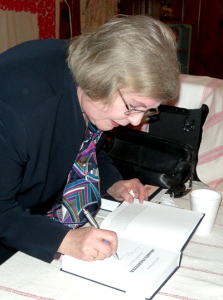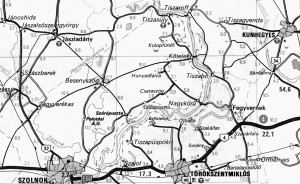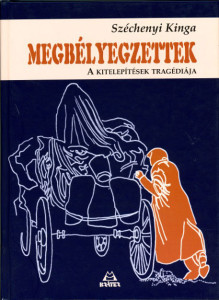
Széchenyi Kinga
Megbélyegzettek, A kitelepítések tragédiája
(Stigmatized, The tragedy of deportations)

The houses and apartments of the deportees were confiscated along with all their valuables, and the families were relocated to villages and farms in Szolnok, Békés, Heves, Hajdú-Bihar, Borsod-Abaúj-Zemplén, Szabolcs-Szatmár and Pest Counties. Each deportee family was assigned a room (some rooms were occupied by more than one family) mostly in houses owned by „kulaks” (wealthy farmers) or sometimes even in stables. They were required to stay there under miserable conditions and the constant surveillance and raids of the local police. They were forbidden to cross the border of their assigned village, and if someone violated this rule, the punishment was internment. Only the county police was entitled to grant permission for deportees to go to a nearby town, and those permissions were granted very rarely, e.g. for urgent medical reasons. It was not easy for the deportees to find employment and they were only hired to perform manual labour, mainly in agriculture, and received the lowest possible wages. Their children were not allowed to attend secondary school; from age fourteen they worked in the fields with the adults.
The first part of the book discusses the atrocities of the Rákosi regime, including the different kinds of deportations and internments, but its main topic is the deportations from the capital. This part is based on the now public but incomplete documents that show how the lists were prepared, what the alleged „legal” bases were for the deportations, how the deportations were carried out, and also shows the severe restrictions imposed upon the deportees. It deals with exemptions and applications for resettlement, most of which were rejected. The book discusses the severe trials to which the deportees were subjected, which often became even more serious when deportees were imprisoned or taken either to internment camps or to the forced labour camps of Hortobágy Puszta. The archival research reveals the names of members of different committees responsible for the deportations and the names of high-ranking officers and officials who gave the orders, carried out the deportations, and dealt with the applications of the deportees. The list of villages where the deportees were relocated is also documented in the book.
 In 1953, after Imre Nagy became prime minister, the supplementary measure of the Amnesty Act dissolved the deportations, but did not repeal the legal possibility of later deportations. Subsequently, deportees continued to be homeless, and there were restrictions in regard to where they could settle as they were still banished from Budapest and other important cities. They never regained their homes or possessions and were under police surveillance for decades. Discrimination and stigmatization affected every step of their lives. Later, their applications for rehabilitation were denied because, as the authorities explained, they had never been tried and sentenced. The book discusses the minimal compensation the deportees received for their losses after the political changes that occurred in 1990.
In 1953, after Imre Nagy became prime minister, the supplementary measure of the Amnesty Act dissolved the deportations, but did not repeal the legal possibility of later deportations. Subsequently, deportees continued to be homeless, and there were restrictions in regard to where they could settle as they were still banished from Budapest and other important cities. They never regained their homes or possessions and were under police surveillance for decades. Discrimination and stigmatization affected every step of their lives. Later, their applications for rehabilitation were denied because, as the authorities explained, they had never been tried and sentenced. The book discusses the minimal compensation the deportees received for their losses after the political changes that occurred in 1990.
The book contains a collection of contemporary articles from Hungarian and foreign newspapers regarding the internal deportations, as well as some unproven “myths” reported by Radio Free Europe. The book also discusses similar atrocities in other “socialist” countries, specifically in the Transylvanian region of Romania, where it took much longer, in some cases fourteen years, to end the deportations and resettle the deportees.
In the second half of the book, short memoirs, recollections, diary segments, interviews, and letters of former deportees illustrate the tragedy of the deportations. These writings show that even though a long period of time has passed, there are still former deportees who are unable to recover from their tragic experience. Of course, the deportations created serious trauma even in the lives of those who were able to do so. It is worth comparing the recollections of the ones who have been able to put the deportations in perspective with the writings of those for whom the deportations and their consequences are still very painful, incomprehensible memories. Some of the recollections recount not only the deportees’ years of exile, but also how their lives were affected or even determined, by the inhuman decision made in 1951. On the other hand, they also show how people were able to live, cope and strive for their families and even find some peace of mind under those difficult and cruel circumstances.
This work fills a gap by showing how certain classes of society lived under the Rákosi and Kádár regimes. By revealing some lesser known facts, it contributes significantly to the collective knowledge about the period. It would be important not only for Hungarians, but also for Westeners to know a lot more about the cruel atrocities of the communist era.
Kinga Széchenyi
